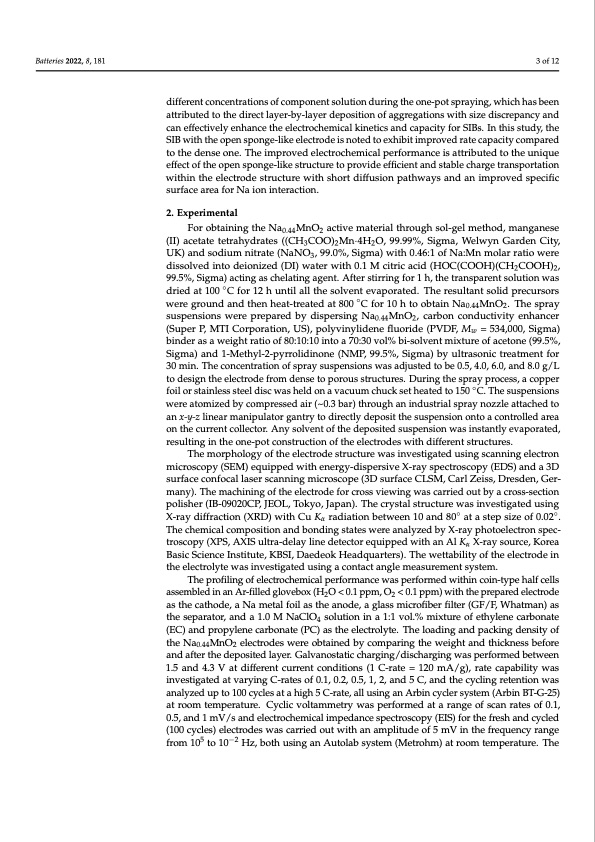
PDF Publication Title:
Text from PDF Page: 003
Batteries 2022, 8, 181 3 of 12 different concentrations of component solution during the one-pot spraying, which has been attributed to the direct layer-by-layer deposition of aggregations with size discrepancy and can effectively enhance the electrochemical kinetics and capacity for SIBs. In this study, the SIB with the open sponge-like electrode is noted to exhibit improved rate capacity compared to the dense one. The improved electrochemical performance is attributed to the unique effect of the open sponge-like structure to provide efficient and stable charge transportation within the electrode structure with short diffusion pathways and an improved specific surface area for Na ion interaction. 2. Experimental For obtaining the Na0.44MnO2 active material through sol-gel method, manganese (II) acetate tetrahydrates ((CH3COO)2Mn·4H2O, 99.99%, Sigma, Welwyn Garden City, UK) and sodium nitrate (NaNO3, 99.0%, Sigma) with 0.46:1 of Na:Mn molar ratio were dissolved into deionized (DI) water with 0.1 M citric acid (HOC(COOH)(CH2COOH)2, 99.5%, Sigma) acting as chelating agent. After stirring for 1 h, the transparent solution was dried at 100 ◦C for 12 h until all the solvent evaporated. The resultant solid precursors were ground and then heat-treated at 800 ◦C for 10 h to obtain Na0.44MnO2. The spray suspensions were prepared by dispersing Na0.44MnO2, carbon conductivity enhancer (Super P, MTI Corporation, US), polyvinylidene fluoride (PVDF, Mw = 534,000, Sigma) binder as a weight ratio of 80:10:10 into a 70:30 vol% bi-solvent mixture of acetone (99.5%, Sigma) and 1-Methyl-2-pyrrolidinone (NMP, 99.5%, Sigma) by ultrasonic treatment for 30 min. The concentration of spray suspensions was adjusted to be 0.5, 4.0, 6.0, and 8.0 g/L to design the electrode from dense to porous structures. During the spray process, a copper foil or stainless steel disc was held on a vacuum chuck set heated to 150 ◦C. The suspensions were atomized by compressed air (~0.3 bar) through an industrial spray nozzle attached to an x-y-z linear manipulator gantry to directly deposit the suspension onto a controlled area on the current collector. Any solvent of the deposited suspension was instantly evaporated, resulting in the one-pot construction of the electrodes with different structures. The morphology of the electrode structure was investigated using scanning electron microscopy (SEM) equipped with energy-dispersive X-ray spectroscopy (EDS) and a 3D surface confocal laser scanning microscope (3D surface CLSM, Carl Zeiss, Dresden, Ger- many). The machining of the electrode for cross viewing was carried out by a cross-section polisher (IB-09020CP, JEOL, Tokyo, Japan). The crystal structure was investigated using X-ray diffraction (XRD) with Cu Kα radiation between 10 and 80◦ at a step size of 0.02◦. The chemical composition and bonding states were analyzed by X-ray photoelectron spec- troscopy (XPS, AXIS ultra-delay line detector equipped with an Al Kα X-ray source, Korea Basic Science Institute, KBSI, Daedeok Headquarters). The wettability of the electrode in the electrolyte was investigated using a contact angle measurement system. The profiling of electrochemical performance was performed within coin-type half cells assembled in an Ar-filled glovebox (H2O < 0.1 ppm, O2 < 0.1 ppm) with the prepared electrode as the cathode, a Na metal foil as the anode, a glass microfiber filter (GF/F, Whatman) as the separator, and a 1.0 M NaClO4 solution in a 1:1 vol.% mixture of ethylene carbonate (EC) and propylene carbonate (PC) as the electrolyte. The loading and packing density of the Na0.44MnO2 electrodes were obtained by comparing the weight and thickness before and after the deposited layer. Galvanostatic charging/discharging was performed between 1.5 and 4.3 V at different current conditions (1 C-rate = 120 mA/g), rate capability was investigated at varying C-rates of 0.1, 0.2, 0.5, 1, 2, and 5 C, and the cycling retention was analyzed up to 100 cycles at a high 5 C-rate, all using an Arbin cycler system (Arbin BT-G-25) at room temperature. Cyclic voltammetry was performed at a range of scan rates of 0.1, 0.5, and 1 mV/s and electrochemical impedance spectroscopy (EIS) for the fresh and cycled (100 cycles) electrodes was carried out with an amplitude of 5 mV in the frequency range from 105 to 10−2 Hz, both using an Autolab system (Metrohm) at room temperature. ThePDF Image | Cathode Electrodes High-Rate Cycle-Stable Na-Ion Batteries

PDF Search Title:
Cathode Electrodes High-Rate Cycle-Stable Na-Ion BatteriesOriginal File Name Searched:
batteries-08-00181-v3.pdfDIY PDF Search: Google It | Yahoo | Bing
Salgenx Redox Flow Battery Technology: Salt water flow battery technology with low cost and great energy density that can be used for power storage and thermal storage. Let us de-risk your production using our license. Our aqueous flow battery is less cost than Tesla Megapack and available faster. Redox flow battery. No membrane needed like with Vanadium, or Bromine. Salgenx flow battery
| CONTACT TEL: 608-238-6001 Email: greg@salgenx.com | RSS | AMP |